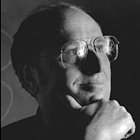Commentary: Abe Seiden
 |
| Photo: Monica Lee |
The Particle Physics Roadmap
In October 2006, the Particle Physics Project Prioritization Panel (P5) provided a new roadmap for a broad and very exciting science agenda in particle physics research. The roadmap’s destinations are among the most intriguing questions in science: the origins of mass and the search for the Higgs boson; extra dimensions; dark matter and dark energy; unification of the known forces and possible new forces; the three families of matter, from the massive top quark to the near-massless neutrino; and CP violation, the key to the imbalance between matter and antimatter in the universe.
The P5 plan recommends construction and R&D toward major projects for the next five years, within an international context, and within budget guidance from the US Department of Energy (DOE) and the National Science Foundation (NSF). There are recommended review dates for projects anticipated to be ready for construction early in the next decade. Along with ongoing projects, and projects with construction nearing completion, these recommendations form the new roadmap.
P5 is a subpanel of the High Energy Physics Advisory Panel, chartered jointly by DOE and NSF. HEPAP endorsed the P5 plan in October 2006. The P5 panel received important input from specialized assessment panels in individual physics areas, and from the report of the Committee on Elementary Particle Physics in the 21st Century (EPP2010), Revealing the Hidden Nature of Space and Time: Charting the Course for Elementary Particle Physics. The P5 recommendations converge on these major scientific opportunities: the energy frontier of the Large Hadron Collider and the proposed International Linear Collider; the nature of dark matter and dark energy; neutrinos; and precision measurements with charged leptons or quarks.
There is enormous potential for across-the-frontier discovery projects at the LHC and ILC, with the LHC addressing the full spectrum of science questions from the nature of mass, to dark matter and dark energy, unification, and CP violation. Neutrino science investigations would encompass neutrinoless double-beta decay, reactor and accelerator neutrino oscillation experiments, and neutrinos from space.
A program to understand dark matter, complementary to work in astrophysics, seeks to study its particle nature directly in the laboratory. However, dark energy can only be studied (at our present level of understanding) through astronomical observations; therefore, projects typically involve interagency collaborations with the astronomy programs at NSF or NASA.
For major construction and R&D over the rest of this decade, P5 set these three priorities: research at the energy frontier, including the full LHC program and R&D for the ILC; a near-term program in dark matter and dark energy, as well as measurement of the small neutrino-mixing angle; and construction of the NOνA neutrino-oscillation experiment, along with related modest Fermilab accelerator complex improvements.
The dark matter and dark energy program includes the 25 kg Cryogenic Dark Matter Search (CDMS), the Dark Energy Survey (DES), and finalizing a cost and schedule plan for two dark energy projects: The Large Synoptic Survey Telescope, in collaboration with the NSF; and SNAP, one of three options for a dark energy space mission. DOE should work with NASA to determine the best space mission.
Neutrino efforts include the Daya Bay (China) reactor neutrino experiment, along with R&D for a Deep Underground Science and Engineering Lab (DUSEL), R&D for a large dark matter detector, and a neutrinoless double-beta decay experiment to be located at DUSEL.
P5 advocated a review toward the end of this decade for a number of projects, many of which could start construction soon thereafter. ILC progress will be reviewed, including a possible US bid to host the ILC. The LHC upgrade construction is required to raise LHC luminosity tenfold. DUSEL, including the large dark matter and neutrinoless double-beta decay experiments that it could host, will be reviewed. The two large dark energy experiments will need to be revisited. The status of flavor physics, and the importance of further new charged lepton or quark flavor experiments, will also be monitored. The best directions for further neutrino physics experiments would be based on the physics results over the next five to ten years.
With appropriate reviews, new discoveries, adaptations to budget constraints, and progress on interagency and international collaboration, projects on the P5 roadmap are poised to make significant discoveries in the years ahead.
Abraham Seiden is the chair of the P5 subpanel and a physicist at the University of California, Santa Cruz. The full P5 report is available online.
Click here to download the pdf version of this article.


